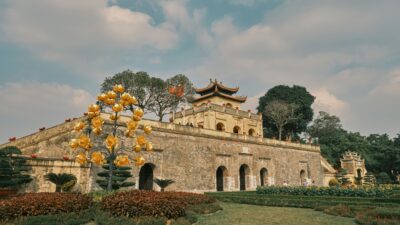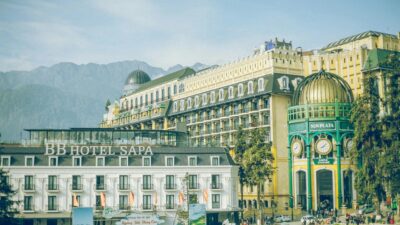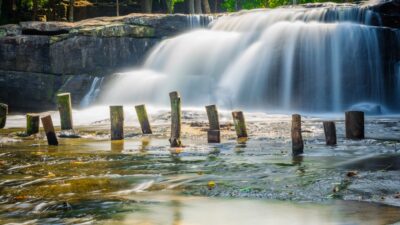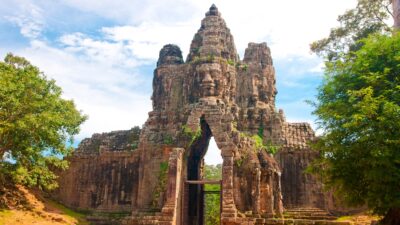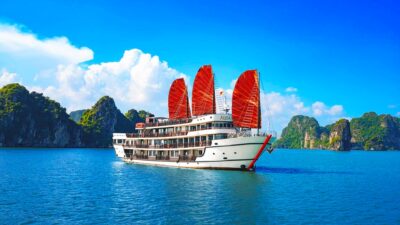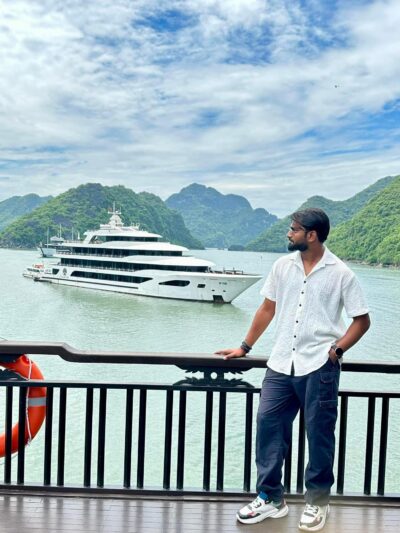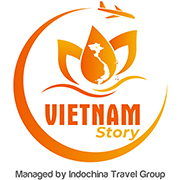Prepare to be rewarded with Ninh Binh’s most breathtaking panoramic views from the summit of Mua Caves (Hang Mua), an ascent atop Ngoa Long Mountain (Lying Dragon Mountain) that you won’t soon forget! This isn’t just a cave in the traditional sense; Mua Caves Ninh Binh, part of the renowned Trang An Landscape Complex, a UNESCO World Heritage Site, is celebrated for its spectacular viewpoint. This vantage point is reached by ascending nearly 500 stone steps, offering unparalleled vistas of the Tam Coc region, the winding Ngo Dong River, and the iconic limestone karsts that define Ninh Binh’s ethereal beauty. For first-time visitors to Ninh Binh, adventure seekers, and anyone seeking that perfect photograph, conquering Mua Caves is an absolute must-do, offering a profound glimpse into Vietnam’s natural heritage and Cultural Significance.
Discovering Mua Caves (Hang Mua) – The Jewel of Ninh Binh
Mua Caves, or Hang Mua in Vietnamese, is majestically perched atop Ngoa Long Mountain, also known as Lying Dragon Mountain. Nestled in the heart of Ninh Binh Province, Vietnam, it lies amidst a stunning canvas of verdant rice paddies and dramatic limestone karsts, a hallmark of the region’s Natural Beauty. As a significant part of the Trang An Landscape Complex, a UNESCO World Heritage Site, Mua Caves holds immense appeal.
Why is Mua Caves a must-visit destination? It’s revered for its unparalleled beauty, rich cultural tapestry, and the thrilling adventure it promises. The reward for the physical challenge of the climb is a breathtaking panoramic viewpoint, making it a top hiking destination in Vietnam. It’s more than just a view; it’s an experience that encapsulates the unique characteristics of this incredible landscape.

The Legend Behind the Name: The “Dancing Cave”
The name “Mua Caves” carries a charming legend. “Mua” translates to “dancing” in Vietnamese. Folklore tells of King Tran Thai Tong, a key historical figure, who frequented this area on Ngoa Long Mountain. He is said to have enjoyed royal performances by talented women in the cave, leading to its evocative name, Hang Mua or the “Dancing Cave.” This legend deeply intertwines with the site’s cultural significance and historical aspect.
Beyond its legendary and natural appeal, Mua Caves holds a unique place in Vietnam’s history. During the resistance wars, the base of Mua Mountain (Ngoa Long Mountain) served a critical role as a mobile hospital, a rare attribute that adds another layer to its profound story.
Location and How to Get There
Mua Caves is located in Khe Dau Ha Hamlet, Ninh Xuan Commune, Hoa Lu District, Ninh Binh Province, right at the foot of Mua Mountain (Ngoa Long Mountain).
Distance from Key Points:
- Approximately 10 kilometers from Ninh Binh City (some sources say around 6 km).
- About 5 kilometers north of Tam Coc, making for a quick 10-minute motorbike ride.
- Roughly 90 to 100 kilometers south of Hanoi.
- Around 15 km from the Ninh Binh railway station.
Getting to Mua Caves (Hang Mua):
If you’re wondering “how to get to Mua Caves from Hanoi,” several options exist:
- Train: A comfortable journey of about 2 hours.
- Bus/Coach: An economical option, taking around 2.5 to 3 hours.
- Motorbike: For the adventurous, a 2-hour ride through the countryside.
- Private Car/Tour: Offers convenience and flexibility, often included in tours designed for travelers, including those from India seeking a comprehensive experience.
From Ninh Binh City, Tam Coc, or the railway station, taxis, motorbike taxis (xe om), or rented bicycles are popular choices. Cycling from Tam Coc is particularly scenic.
Directions:
Take National Highway 1A towards Ninh Binh City. From there, follow signposts for Trang An or Tam Coc. Clear signs for the Hang Mua tourist area will guide you. Alternatively, Road 477 from Ninh Binh city also leads to Mua Caves.
Parking:
Ample parking is available near the entrance and ticket counter. Fees are typically around 10,000–15,000 VND for motorbikes and 20,000–30,000 VND for cars, though some sources suggest parking might be included with the entrance fee.
Mua Caves Entrance Fee and Opening Hours
For those planning a visit, the “Mua Caves Ninh Binh entrance fee and opening hours” are key details. The entrance fee is generally 100,000 VND per adult (approximately $4 USD). Children under 1 meter in height are often admitted free, making it a family-friendly consideration. Mua Caves is typically open daily, with opening hours usually from around 6:00 AM to 7:00 PM, though slight variations (e.g., 7 AM – 5 PM) can occur. The entrance ticket usually grants access to the entire complex, including the popular lotus lake and surrounding gardens.

Things to Do and See at Mua Caves
Mua Caves offers a wealth of experiences, appealing to adventurers, photographers, and culture enthusiasts alike.
Hike the Iconic 500-Step Stone Staircase
The main attraction is undoubtedly the rewarding climb up the stone staircase. This physical challenge involves ascending approximately 486 to 500 steps that wind their way up Mua Mountain (Ngoa Long Mountain). The staircase itself is an impressive feat, often likened to a mini “Great Wall of Vietnam.” The climb, taking about 20-45 minutes depending on your pace, is an adventure in itself. Along the path, look for intricately sculpted stone statues depicting mythical creatures like dragons and phoenixes – potent symbols in Vietnamese folklore. The path may fork, leading to different viewpoints or the main pagoda and statues. The majestic Dragon Sculpture curves along the ridgeline near the summit and is said to be the tallest in Ninh Binh, a truly Instagrammable spot for visitors from India and all over the world.
Enjoy Breathtaking Panoramic Views
The unparalleled panoramic viewpoint from the summit is the ultimate reward. It’s a unique characteristic of Mua Caves, offering mesmerizing 360-degree vistas. From here, you can feast your eyes on the sweeping Tam Coc valley, the serene Ngo Dong River meandering through golden or green rice paddies, the dramatic limestone karsts, the distant Bich Dong Pagoda, and the historic ancient capital of Hoa Lu.

Capture Stunning Photos
Mua Caves is a photographer’s paradise, aligning perfectly with the Photography Aspect of the visit. For the “best time to visit Mua Caves Ninh Binh for photos,” early morning or late afternoon light is ideal. Summit spots for iconic photos include the traditional Vietnamese-style Pagoda, the “virtual tower” (often the tallest structure offering fantastic shots), an eagle statue symbolizing power, and the serene statue of Avalokitesvara (Quan The Am Bodhisattva). Don’t miss capturing the stone staircase with its magnificent dragon sculpture, the tranquil lotus pond with its charming wooden pathway, and the unique rock formations inside the small cave itself. Many visitors also enjoy the giant cactus garden and artificial waterfall for quirky check-in photos.
Explore the Cave Itself (Hang Mua):
While the viewpoint is the star, the actual cave near the entrance, sometimes referred to as Tiger Cave, is worth a brief exploration. It’s not extensive but features stalactites, stalagmites, and rock formations, and is tied to the “Dancing Cave” legend. It can be dark and damp, so a flashlight and good footwear are recommended.
Stroll through the Lotus Pond and Flower Garden:
At the foot of the mountain, near the entrance, lies a beautiful lotus pond. During the lotus blooming season (typically late May to early July), the pond is a vibrant spectacle of pink and white flowers. A wooden pathway or bridge allows for a tranquil walk and offers excellent photo opportunities, capturing the serene beauty that appeals to all visitors, including those from India looking for peaceful and picturesque settings.
Best Time to Visit Mua Caves Ninh Binh
Choosing the “best time to visit Mua Caves Ninh Binh” significantly enhances your experience.
Best Seasons for Optimal Scenery and Comfort:
- Ripe Rice Season (Late May to early July): This is arguably the most picturesque time. The rice paddies transform into a stunning golden carpet, creating breathtaking landscapes. The weather is generally pleasant, making it a highly recommended period for visitors, including Indian tourists who appreciate vibrant landscapes.
- Cooler/Dry Season (October to April, especially November to April): During these months, the temperature is mild, and the sky is often clear. It’s cooler and drier, providing more comfortable climbing conditions and fewer crowds, though the rice fields might be green or fallow rather than golden.
Visiting at the start of the year or from October to December also generally offers vibrant scenery and good weather.
Avoid:
August and September often mark the peak of the rainy season. Heavy showers can make paths slippery and potentially limit visibility, so it’s best to avoid this period if possible.
Best Time of Day for the Ascent and Views:
- Early Morning (Sunrise – around 6 AM): The ideal time. Temperatures are cooler, crowds are thinner, and the soft morning light is perfect for photography, especially for capturing the lotus flowers glistening with dewdrops. Witnessing the sunrise over the karst landscape is a truly magical experience.
- Late Afternoon (Sunset): Another excellent choice. The sun is not too harsh, and the golden hour light provides dramatic views and colors as the sun sets over Tam Coc. However, it can be a peak hour with more visitors.
It’s advisable to avoid climbing during the midday heat (11 AM – 2 PM) as it can be quite intense with little shade on the stairs.
Local Cuisine Near Mua Caves
Ninh Binh is renowned for its rich and diverse cuisine, an integral part of its Cultural Significance. After your climb, or during your stay in the area, be sure to try some local specialties. Many nearby eateries, restaurants, and homestays offer authentic Ninh Binh dishes, providing a delightful culinary experience for all travelers.
Must-Try Specialties:
- Mountain Goat Meat (Dê Núi): A signature dish of Ninh Binh, famous for its unique texture and taste. It’s prepared in various ways – grilled, steamed, in a hot pot, or even raw with lemon and herbs. Often served with a special goat-based dipping sauce.
- Ninh Binh Crispy Rice (Cơm Cháy): A crunchy, savory delicacy. This scorched rice is often enjoyed with a rich goat meat sauce or a pork floss topping. It also makes a great souvenir.
- Mountain Snails (Ốc Núi): Often steamed with lemongrass or stir-fried, these snails have a distinct flavor.
- Rice Wine (Rượu Cần or Kim Sơn Wine): Locally produced rice wine offers a taste of traditional Vietnamese spirits.
- Nem Yen Mac: A traditional fermented pork roll, a delicacy from the Yen Mac village.
- Goi Ca Nhech (Raw Fermented Eel Salad): A unique and flavorful local specialty.
- Lotus-based dishes: Given the prevalence of lotus ponds, dishes like lotus seed soup or sticky rice with lotus seeds are common and delicious.

Nearby Attractions
Mua Caves is perfectly situated within the Trang An Landscape Complex surrounded by a host of other captivating destinations. This makes it easy to create a full day or multi-day itinerary. Many tours, including those catering to Indian tourists, combine Mua Caves with these sites.
- Tam Coc: Often called the “Halong Bay on Land.” Famous for its scenic boat rides on the Ngo Dong River, passing through three natural caves. Located just about 4-5 km away.
- Trang An Scenic Landscape Complex: A UNESCO World Heritage Site offering stunning boat tours through a network of caves, temples, and emerald waterways amidst dramatic karst formations.
- Hoa Lu Ancient Capital: The former capital of Vietnam in the 10th and 11th centuries. Explore ancient temples dedicated to the Dinh and Le dynasties, located about 10 km from Mua Caves.
- Bai Dinh Pagoda: One of the largest Buddhist temple complexes in Southeast Asia, featuring ancient pagodas and impressive new structures with grand statues. It’s about 15 km away.
- Bich Dong Pagoda: A beautiful, ancient three-tiered pagoda built into a limestone mountain, part of the larger Tam Coc-Bich Dong area.
- Van Long Nature Reserve: A pristine wetland area, home to diverse flora and fauna, including the endangered Delacour’s langur. Offers peaceful boat tours. About 17 km from Mua Caves.
- Thung Nham Bird Park: An excellent eco-tourism site, especially for bird watchers. Visit in the late afternoon to see thousands of birds returning to roost. Also features caves.
It’s very feasible to visit Mua Caves and Tam Coc, or other nearby sites like Trang An or Hoa Lu, within the same day, making for a rich exploration of Vietnamese tourism highlights and UNESCO World Heritage Sites.
Practical Tips for a Smooth Trip to Mua Caves (Hang Mua)
To make the most of your visit and handle the Physical Challenge, keep these tips in mind, which address some common Assumptions and Premises for visitors.
- Check the Weather: Before your trip, check the local weather forecast.
- Footwear is Key: Wear comfortable and sturdy shoes – sneakers, trainers, or hiking shoes are ideal. The stone steps can be uneven, steep, and slippery, especially after rain. Avoid flip-flops. This is crucial for the “what to wear when climbing Mua Caves” query.
- Dress Comfortably: Light, breathable clothing is recommended, especially in Vietnam’s warm and humid climate.
- Stay Hydrated: Carry plenty of water, especially for the climb. There is little shade on the stairs. You can buy water at the base.
- Sun Protection: Bring sunscreen, sunglasses, and a hat, as the summit and much of the climb are exposed to the sun.
- Insect Repellent: Can be helpful, particularly near water sources or in the early morning/late evening.
- Respectful Attire: If you plan to enter the pagoda at the summit or other religious sites, ensure your shoulders and knees are covered. Familiarize yourself with local customs.
- Environmental Responsibility: Dispose of all waste properly. Help keep this beautiful site clean.
- Fitness Level: Be honest about your fitness. The climb involves nearly 500 steps and is moderately challenging. Take breaks as needed; there are spots to rest along the way.
- Camera Ready: Bring your camera with a fully charged battery and enough memory. A wide-angle lens can be great for the panoramic views. A tripod might be useful for sunrise/sunset shots.
- Bring Cash: Cash (VND) is often preferred for the entrance fee, parking, drinks, snacks, and at smaller eateries.
Accommodation Near Mua Caves
Finding “accommodation near Mua Caves Ninh Binh” is easy, with options catering to various budgets and preferences, forming part of the local Tourism Infrastructure Aspect.
- Mua Caves Ecolodge (Hang Mua Ecolodge): Located right at the base of Mua Mountain, offering unparalleled convenience for early morning hikes or late sunset views. Often features charming bungalows.
- Tam Coc Garden Resort: An upscale, eco-conscious option offering a luxurious and tranquil experience, about 5 km away.
- Ninh Binh Hidden Charm Hotel & Resort: A high-end choice in the Tam Coc area with excellent amenities.
- Homestays in Tam Coc and Ninh Xuan: Many charming and affordable homestays offer a more local experience, often surrounded by rice paddies.
- Budget Hostels and Guesthouses: Numerous budget-friendly options can be found in Tam Coc town or Ninh Binh city.
Staying nearby allows you to easily access Mua Caves at optimal times and explore the surrounding attractions without hassle.
Conclusion
Mua Caves Ninh Binh offers an unforgettable journey through stunning Natural Beauty, exhilarating Adventure/Hiking, rich Cultural Significance, and unparalleled Photography opportunities. It stands out as a Unique Characteristic of Ninh Binh and the greater Trang An Landscape Complex.
Whether you are drawn by the Physical Challenge of conquering the nearly 500 Steps to reach the iconic Dragon Statue and serene Pagoda at the summit, the tranquility of the Lotus Pond at its base, or the promise of awe-inspiring panoramic viewpoints over Tam Coc and the majestic limestone karsts, Mua Caves (Hang Mua) delivers an exceptional experience. It is more than just a Ninh Binh viewpoint; it’s a true gem in Vietnam, connecting visitors to the heart of Vietnamese tourism and showcasing the best of Eco-tourism. A visit here will undoubtedly be a highlight of any trip to Vietnam, leaving you with cherished memories and breathtaking photographs.




